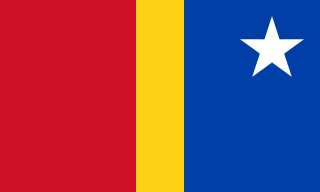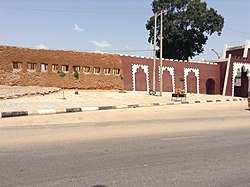
Kano is a city in northern Nigeria and the capital of Kano State. It is the second largest city in Nigeria after Lagos, with over ten million citizens living within 449 km2 (173 sq mi). Located in the Savanna, south of the Sahel, Kano is a major route of the trans-Saharan trade, having been a trade and human settlement for millennia. It is the traditional state of the Dabo dynasty who have ruled as emirs over the city-state since the 19th century. Kano Emirate Council is the current traditional institution inside the city boundaries of Kano, and under the authority of the Government of Kano State.
The Kano Chronicle is an Arabic-language manuscript that lists the rulers of Kano.

Kano State is one of the 36 states of Nigeria, located in the northern region of the country. According to the national census done in 2006, Kano State is the most populous state in Nigeria. The recent official estimates taken in 2016 by the National Bureau of Statistics found that Kano State was still the largest state by population in Nigeria. Created in 1967 out of the former Northern Region, Kano State borders on Katsina State to the northwest for about 210 km, Jigawa State to the northeast for 355 km, Bauchi State to the southeast for 131 km, and Kaduna State to the southwest for 255 km. The state's capital and largest city is the city of Kano, the second most populous city in Nigeria after Lagos. The incumbent governor of the state is Abba Kabir Yusuf. He was sworn in on 29 May 2023.
Ali Dan Tsamiya known as Yaji I or Ali Yaji Dan Tsamiya was a king and later the first Sultan of Kano, a state in what is now Northern Nigeria. Yaji I ruled from 1359 to 1385 CE. A prominent figure in the state's history, Yaji used a religious revolution to finally solidify his family's grasp on Kano and its sub-kingdoms after centuries of strife. He was also responsible for the absorption of Rano into Kano.

Hausa Kingdoms, also known as Hausa Kingdom or Hausaland, was a collection of states started by the Hausa people, situated between the Niger River and Lake Chad. Hausaland lay between the Western Sudanic kingdoms of Ancient Ghana, Mali and Songhai and the Eastern Sudanic kingdoms of Kanem-Bornu. Hausaland took shape as a political and cultural region during the first millennium CE as a result of the westward expansion of Hausa peoples. They arrived to Hausaland when the terrain was converting from woodlands to savannah. They started cultivating grains, which led to a denser peasant population. They had a common language, laws and customs. The Hausa were known for fishing, hunting, agriculture, salt-mining, and blacksmithing.

Jukun are an ethno-linguistic group or ethnic nation in West Africa. The Jukun are traditionally located in Taraba, Benue, Nasarawa, Plateau, Adamawa, Bauchi and Gombe States in Nigeria and parts of northwestern Cameroon. They are descendants of the people of Kwararafa. Most of the tribes in the north central of Nigeria trace their origin to the Jukun people and are related in one way or the other to the Jukuns. Until the coming of both Christianity and Islam, the Jukun people were followers of their own traditional religions. Most of the tribes, Alago, Agatu, Rendere, Goemai in Shendam, and others left Kwararafa when it disintegrated as a result of a power tussle. The Jukuns are divided into two major groups; the Jukun Wanu and Jukun Wapa. The Jukun Wanu are fishermen residing along the banks of the river Benue and Niger where they run through Taraba State, Benue State and Nasarawa State. The Wukari Federation, headed by the Aku Uka of Wukari, is now the main centre of the Jukun people.
Bayajidda was, according to the legends surrounding most West African states before the 19th century, the founder of the Hausa states.

The Hausa are a native ethnic group in West Africa. They speak the Hausa language, which is the second most spoken language after Arabic in the Afro-Asiatic language family. The Hausa are a culturally homogeneous people based primarily in the Sahelian and the sparse savanna areas of southern Niger and northern Nigeria respectively, numbering around 86 million people, with significant populations in Benin, Cameroon, Ivory Coast, Chad, Central African Republic, Togo, Ghana, as well as smaller populations in Sudan, Eritrea, Equatorial Guinea, Gabon, Senegal and the Gambia.

Dalla Hill is a hill in Kano, Kano State, Nigeria. It is 534 metres (1,753 ft) high and contains a stairway with 101 steps to the bottom to top.

The Kano Emirate was a Muslim state in Northern Nigeria formed in 1805 during the Fulani jihad when the Muslim Hausa-led Sultanate of Kano was deposed and replaced by a new emirate which became a vassal state of the Sokoto Caliphate. During and after the British colonial period, the powers of the emirate were steadily reduced. The emirate is preserved and integrated into modern Nigeria as the Kano Emirate Council.
The Sultanate of Kano was a Hausa kingdom in the north of what is now Nigeria that dates back to 1349, when the king of Kano, Ali Yaji (1349–1385), dissolved the cult of Tsumbubra and proclaimed Kano a sultanate. Before 1000 AD, Kano had been ruled as an Animist Hausa Kingdom, the Kingdom of Kano. The sultanate lasted until the Fulani Jihad in 1805 and the assassination of the last sultan of Kano in 1807. The sultanate was then replaced by the Kano Emirate, subject to the Sokoto Caliphate. The capital is now the modern city of Kano in Kano State.
The Battle of Santolo was a decisive battle between the newly declared Kano Sultanate and the Animist Hausa Kingdom of Santolo, it was the first recorded Islamic Jihad waged and fought in Sudanic Africa.
The history of Northern Nigeria covers the history of the region form pre-historic times to the modern period of Northern Nigerian state.
The following is a timeline of the history of the city of Kano, Nigeria.
Kanajeji Dan Yaji, known as Kanajeji, was the 13th ruler of Kano and, for a period, the ruler of Zazzau. He reigned from 1390 - 1410. Like his father, Yaji I, Kanajeji was an intrepid king whose reign was characterized by war, conquest, and religious reformation. Kanajeji engaged in two long and pivotal wars with Umbatu and Zazzau, and eventually prevailed in both, after lengthy feuds. He took Umbatu in four attempts, and Zazzau after two battles. He also renewed the suzerainty his father had imposed over the Kwararafa. However, in a bid to conquer Zazzau, his reign also saw the return of the pagan practices his father sought to expunge. He is credited with revolutionizing Kano's army through the introduction of quilted leather armors (lifidi), steel armors, coats of mail, and iron helmets.
Muhammad Bugaya Dan Tsamiya, known as Bugaya, was a King of Kano who reigned from 1385 - 1390.
The Bagauda Dynasty is a house of noblemen who founded and ruled the Kingdom of Kano throughout its existence. The Dynasty spanned over 800 years spread out through ten centuries, one of the longest in recorded human history and produced 43 rulers. After the fall of the dynasty in Kano, the remnants of the royal house founded a new kingdom in the Maradi Region.
Daud Dan Bawo, also known as Bagauda or Yakano, was the first King of Kano, reigning from 999 to 1063. He established a dynasty which would go on to rule the state for over 800 years. According to the Kano Chronicle, all subsequent Kings and Sultans of Kano descended from him.
Warisi was the King of Kano from 1063 to 1095. He was the son of Bagauda and Saju.








